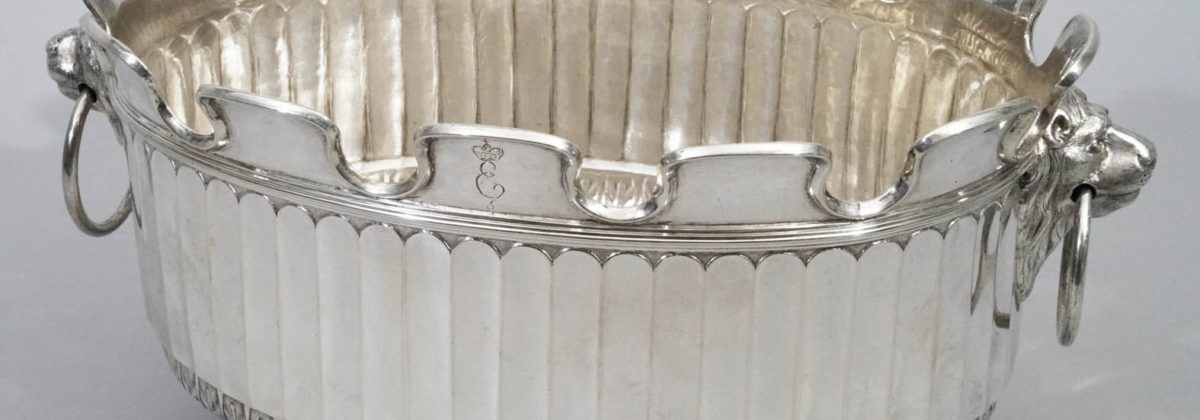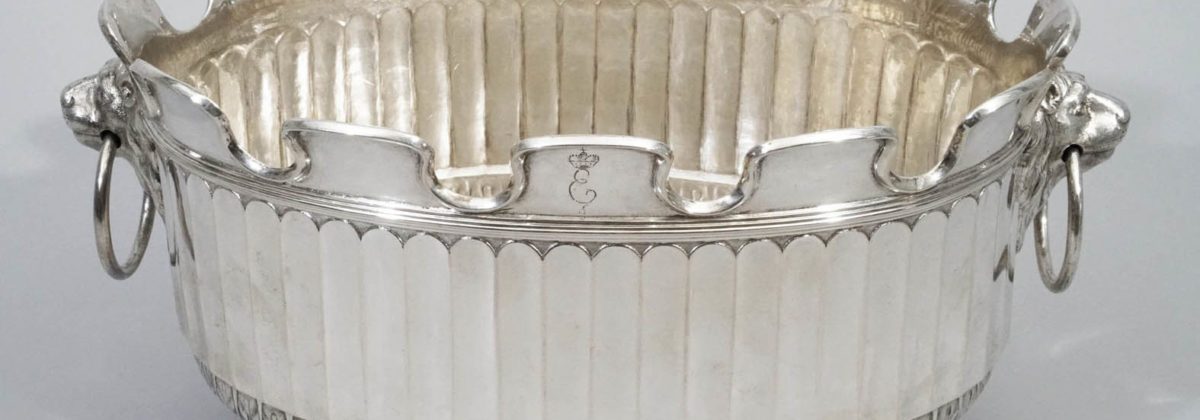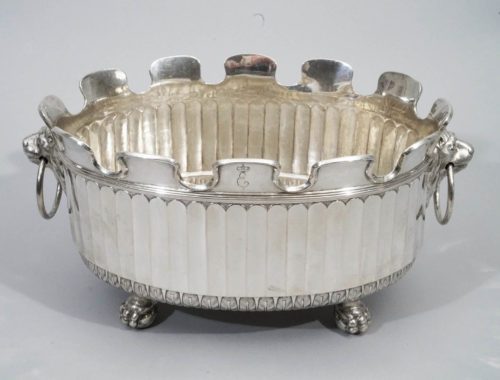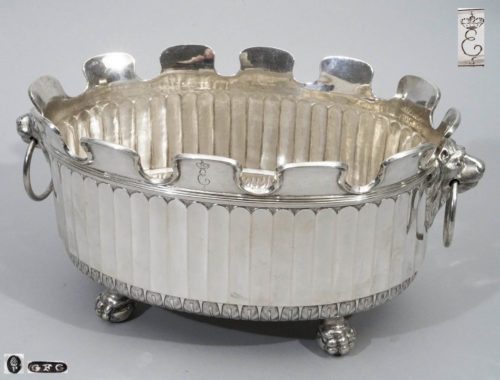Objektnummer #323
Augsburg 1804/5
Gustav Friedrich Gerich
Silver, chassed, cast, chiseled, engraved
Town mark, maker’s mark and control zig-zag in the center on the bottom of the object:
Town mark: “pyr” for Augsburg 1804/5 (Seling 2007 vol. 3, no. 2880)
Master’s mark: “GFG” for Gustav Friedrich Gerich (Seling 2007, no. 2524)
Monogram: “E” under duke’s crown for Duke Ernst I of Saxe-Coburg-Gotha with the engraved inventory number “5” underneath.
Length: 35 cm (13,7 in.); width: 22 cm (8,6 in.); weight 2270 g (80,07 oz.)
Detailed Information
Neoclassical silver glass cooler from the property of Duke Ernst I of Saxe-Coburg-Gotha
The oval glass cooler – monteith bowl – is structured by clear, classicistic forms and looks quite modern.
Four muscular, bullet-balancing cast lion paws carry the elegant glass cooler. As handle serve two cast rings on lion masks which refer as well as the lion’s feet on a tradition of baroque glass coolers. Lion heads and feet can be found, for example, at the prestigious Monteith bowl of Johann Jakob II Bruglocher, Augsburg 1731-1733, in the State Hermitage in St. Petersburg, as well as the magnificent glass cooler by Johann Friedrich Breuer, Augsburg around 1701/11, in the Bavarian National Museum Munich.
In contrast to the traditional lion motif is the neoclassical basic form of the large, for 12 glasses created, elegant cooling vessel. The wall is artfully structured by parallel, vertically rising gadroons. A stylized palmette frieze closes the body downwards, while the upper edge of the noble monteith bowl curves slightly outward, finding a finish reminding of battlements of a tower.
Centrally in the middle of the upper part is the engraved monogram Duke Ernst I of Saxe-Coburg-Gotha. This can also be found on other silver pieces owned by the Duke, as well as pennies from the reign of Ernst I.
For representation, elaborate silverware was of great importance. Valuable glass coolers found their place in the immediate vicinity of the princely table and, at the latest since the 18th century, were considered an integral part of the courtly banquet ceremonial. The bulges were used to hang the precious stemmed glasses into the iced water. The chilled drink could be served to the dining in the tempered glass from the silver buffet.
Silver glass coolers have rarely been preserved and are therefore very precious. The Augsburg Monteith bowl is characterized by the combination of classicist forms and decorative elements with traditional design elements.
Provenance: Duke Ernst I of Saxe-Coburg-Gotha
The present beautiful glass cooler originally belonged to a larger dinner service owned by Duke Ernst I of Saxe-Coburg and Gotha.
A lidded terrine decorated with tongue gadroons and designed in Kantharos form is still in the possession of the “Foundation of the Duke of Saxe-Coburg and Gotha family” in Coburg. It also features classicistic decoration elements and decoration with palmettes and was designed by the Augsburg goldsmith Gustav Friedrich Gerich in 1802. The inventory number 1 was engraved under the monogram Herzog Ernst I (E with princely hat) centered on the lidded terrine (s. Photo of the tureen and a detail with the monogram).
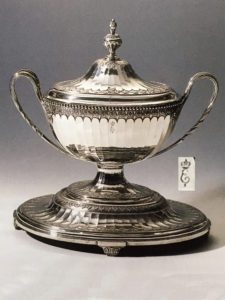
“Two lidded bowls in triangular shape”, manufactured by Gerich in 1803, have the same decor. “The service also included two wine coolers in cylindrical basic shape (with the numbers 1 and 2) and a glass cooler in strict appearance with a vertical wall,” that Gerich made in 1804. Lorenz Seelig already suggested in the catalog of the 1997 exhibition that “once, more lidded bowls were available in different forms” and pointed out that the numbers were the “numbering of the individual service parts”.
The well-known parts of the elaborate table service were created in the years 1802-4. They were made in Augsburg by Gustav Friedrich Gerich and were decorated on a central place the monogram of Duke Ernst Coburg-Saalfeld. I. and service number. Seelig assumed that they were taken either from the silver collection of Duke Franz of Saxe-Coburg-Saalfeld, Ernst’s father and after the official accession 1806 were provided with the princely duke Ernst I. Older silver could also have been acquired later for the silver chamber, as due to the Napoleonic wars and economic and political crises many precious silver objects were found on the market.
Duke Ernst I was declared full of age due to the illness of his father in 1803 and took over after the death of his father in 1806 the government of the Duchy of Saxe-Coburg and Gotha.
Duke Ernst I was closely related to the leading royal houses of his time. He was in 1801 General on horseback under Tsar Alexander I and fought in 1813/14 as a Prussian general under King Friedrich Wilhelm III of Prussia. His sister Juliane (Anna Feodorovna) was married to the Russian Grand Duke Konstantin, the brother of Tsar Alexander I. His younger brother Leopold became king of Belgium in 1831. Ernst I was the father of the British Prince Consort Albert and his sister Victoire, the uncle of the later Queen Victoria of Great Britain and Ireland, thus a direct ancestor of the British royal family of the Windsor.
Maker
Gustav Friedrich Gerich was born in Barfusdorf/Pomerania around 1726. In 1769 he became a master maker and married in the same year for the first time, then again in 1776 and 1795. Gerich died in 1808. His widow Elisabetha Jakobina Mayr continued the workshop after his death.
Several objects of Gustav Friedrich Gerich are in well-known museums such as the Historical Museum of St. Gallen, in the silver chamber of the Munich Residence, in the Württemberg State Museum Stuttgart, in the silver chamber Darmstadt and in the possession of the Foundation of the Duke of Saxe-Coburg and the Gotha Family.
Literature
Andressen B. Michael: Baroque delights at the courts of Europe, Stuttgart / Zurich, 1996, on illustrations of glass coolers, bottle coolers, and swivel vessels from the 15th century onwards.
Baumstark, Reinhold and Seling, Helmut (ed.): Silver and Gold, Augsburger Goldschmiedekunst for the Courts of Europe, exhibition from 23 February to 29 May 1994 in the Bavarian National Museum Munich, Munich 1994, p. XXXI, cat no. 79, 175, the type of vessel and the function of the cooling vessels.
Bosbach, Franz: Windsor-Coburg, Shared Estate – Common Heritage, A Dynasty and its collections, Munich 2007, p. 35 on the equipment of the castles.
Eberle, Martin: The Kunstkammer at Schloss Friedenstein Gotha: Stiftung Schloss Friedenstein, 2010 (From the collections of the Duke of Saxe-Coburg and Gotha Foundation for Art and Science, especially p. 30 on constant changes in the collections.
Henker Michael, u.a. (Hrsg.): A duchy and many crowns, Coburg in Bavaria and Europe, catalog to the national exhibition 1997 of the house of the Bavarian history and the art collections of the Veste Coburg in co-operation with the donation of the duke of Saxonia Coburg and Gotha’schen family and the City of Coburg, Veste Coburg and Callenberg Castle, June 3 to September 28, 1997, therein: Lorenz Seelig, cat. No. 9-14, lidded terrine with saucer plate by Gustav Friedrich Gerich, p. 453f. to the dinner service Duke Ernst I. of Saxe-Coburg and Gotha.
Hernmark, Carl: The Art of the European Gold and Silversmiths 1450-1830, Munich 1978, p. 137 on glass coolers.Seling, Helmut: The art of the Augsburg goldsmith 1529-1868, 3rd volume: master, marks, hallmark, Munich 1980, Seling No. 2524, to Gustav Friedrich Gerich.
Seling, Helmut: The art of the Augsburg goldsmith 1529-1868, vol. 3, master, stamps, hallmark, Munich 2007, Seling No. 2524, to Gustav Friedrich Gerich.


